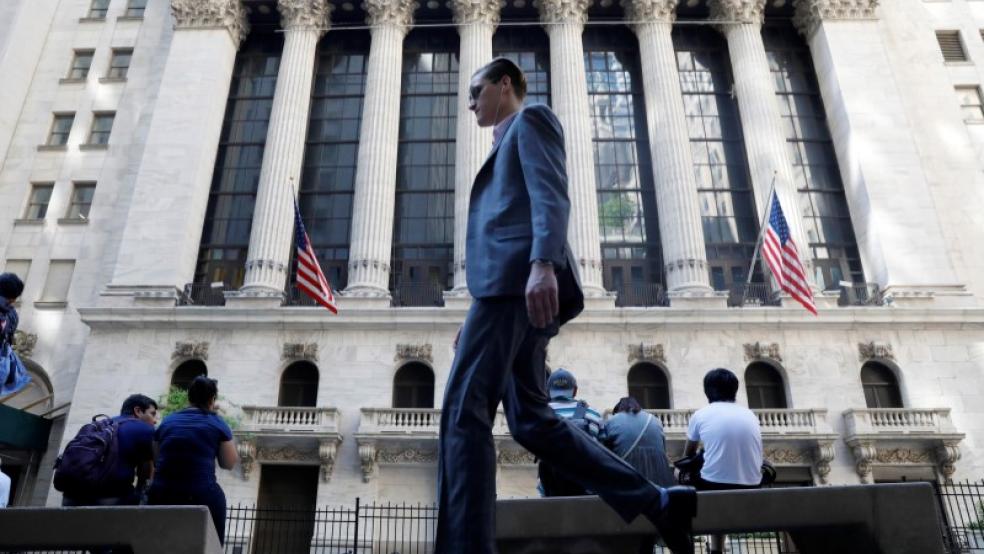The bull-minded optimists that gravitate toward Wall Street are herded and fed by the major investment banks and brokerages, which because of their commission-based business models, try to encourage broad participation in the financial markets. No surprise then that most Wall Street analysts and brokers tend to find the silver lining in everything. Stocks rising? Better buy now before it's too late. Stocks falling? Great, buy more because shares are on sale.
So it came as something of a shock when Bank of America Merrill Lynch strategist Benjamin Bowler headlined a note to clients last month with the warning that, although it's not obvious on the surface, "these markets are very weird" — marked by prolonged periods of extreme calm, easy gains to record highs and chaotic, rapid selling events like the 1.8 percent drop in the S&P 500 on May 17.
The takeaway? Something is broken. The stock market isn't acting normally.
Related: Here’s the Biggest Risk to the Global Economy, According to Pimco
Whether this will result in a severe market correction of the type not seen in years, or is merely a prelude to even higher prices, remains to be seen. But it's noteworthy, both for the uniqueness of the current market environment and for the willingness of a major Wall Street bank to call it out.
Beneath the surface tranquility, oddities abound. Consider, for instance, that 10-year Treasury bonds — a classic safe-haven asset — saw their yields drop to 2.15 percent on Friday, a level not seen since November, and even after a price drip now yield 2.18 percent.
Also unusual: While the major stock averages are at or near all-time highs, only four of the 11 S&P 500 sectors hit new highs. Moreover, two of them (utilities and consumer staples) are defensive in nature. These are the types of stocks you want to own "when you sniff a recession around the corner," according to Gluskin Sheff strategist David Rosenberg.
Related: Will Trump Continue the GOP's Recession Curse?
Bank of America's Bowler, for his part, highlights just how intense the May 17 drop was: It represented a five-standard deviation event relative to recent volatility (which, in statistics speak, represents a massive shift). Equally odd was the speed at which the bulls reversed the decline: The rebound was the second-fastest retracement of five-sigma decline since 1928, a testament to just how strong the "buy-the-dip" mentality is right now.
Bowler added that similar periods of ultra-low volatility occurred in the early 1950s, mid-1960s, mid-1990s and mid-2000s. What's different now is that we’ve seen a higher number of large drawdowns interrupt the tranquility. Examples include last June's Brexit selloff and the Sept. 9, 2016 selloff related to chatter the Bank of Japan could sell long-term bonds to release pressure on pension funds.
Looking ahead, what are some potential "Black Swan" events that could result in further five-sigma drawdowns? Societe Generale, as part of its Global Economic Outlook, listed a few. The largest is a lack of progress on U.S. tax cuts this year, to which they assign 30 percent odds. Other worries include European policy shocks (25 percent odds) and an economic slowdown in China (15 percent odds).
"To our minds," author Michala Marcussen writes, "policy is the main potential source of both upside and downside risk, be it with respect to fiscal expansion, trade policies, wage outcomes, euro area reform or monetary policy."
Related: White House’s Debt Ceiling Battle Could Trigger a Shutdown — and a Recession
Wall Street will be keeping a wary eye on Washington D.C. in the days and weeks to come as the FBI-Trump-Russia story plays out. Based on the testimony fired FBI director James Comey is set to give Congress on Thursday, it's a story that may not have much more traction.
Sam Stovall, chief investment strategist at CFRA, wrote Wednesday: "Politics makes for great headlines, but the economy ultimately drives the bottom line." With no threat of recession in the coming year, in his view, "we continue to believe that dips will offer buying opportunities."
Yet it's hard to dismiss the growing strength in safe-haven assets like Treasury bonds. According to a separate research note from Bank of America Merrill Lynch chief investment strategist Michael Hartnett, the rates market is bracing for a "sharp slowdown in U.S. growth to trend or even below."
Stocks have been in their own world, largely because the bulls have been focused on very strong energy-driven Q1 earnings growth and red-hot "soft" survey-based economic data. According to Hartnett, if the bond market is correct in its dour outlook, stocks are at risk of a 20 percent drop. If the equity market is correct in its optimism, then long-term rates should increase by more than 0.6 percent and any market dips, no matter how scary, are indeed buying opportunities.
Anthony Mirhaydari is founder of the Edge (ETFs) and Edge Pro (Options) investment advisory newsletters. Free two- and four-week trial offers have been extended to Fiscal Times readers.






